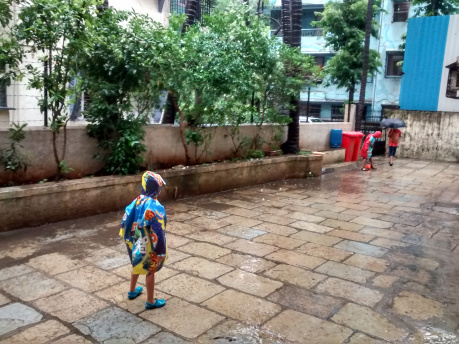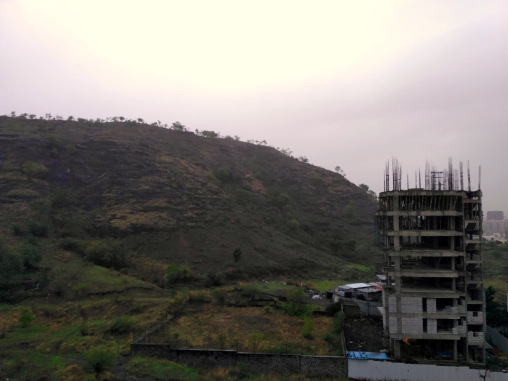Cities have their histories, peoples, cultures, monuments. They have their unique, even overpowering, smells. They have their streets, planned or unplanned, neat or dirty, congested or empty, and so on. Another unique aspect of cities I’ve noticed is their relationship to the rains.
Mumbai, where I have never quite lived, and have never quite stayed away from for more than a year at a time, and where I spent a couple of years in the (then) quaint IIT campus, has a very passionate love-hate relationship with the rains. June, to paraphrase T. S. Eliot [1], is the cruelest month (or half month) in Mumbai, as the city, just coming off a long summer, is at its sweaty worst, with humidity flying off the roof in anticipation of the rains; and if you travel in the local trains at that time of the year, there is only one predominant subject: baarish kab aayegi (when will it rain)? The anticipation of rain in Mumbai is like at no place I know of. Not even the farming villages very immediately dependent on the rains. Maybe it is because, while others are not quite sure, and hence are even afraid of anticipating, lest the rain gods take offense and disappoint, Mumbai is quite sure of the rains, blessed as it is with an abundance, every year. But that’s not all of it. In a city where every square foot seems to be exorbitantly priced and still occupied, rain is a respite from the sweat and the heat, and the sheer monotony of a clockwork industrial life.

Mumbai – A wet game
The ending of the movie The Perfect Murder (1990 – Merchant Ivory Productions) captures the essence of Mumbai’s affair with the first rain — before the drains choke, and local trains stop functioning, and the low-lying areas are flooded, and roads are closed, and it’s already too much rain. The first rain is seen as the solution to all of the city’s problems (as they are the solution to the perfect murder in the city, in the film). The happiness on the streets is comparable to no other collective happiness (except for a cricket World Cup win for India, maybe), as the sheer numbers are on its side. But there is a sense of relief that really underlines the happiness. The megapolis needs the assurance that there will be water, and food, for the next year, just as a farming community in a village needs it, even more, maybe.
But while Mumbai was and is (and will be) my other home, always, the city where I grew up, Solapur, a city past its golden days during the heydays of cloth mills, now a sugar economy, has a very different relationship to rains. Solapur district is highly drought prone, and while keeping aside the irony of massive sugarcane farming in this belt, thanks to the Ujani river dam and canal networks, while the city remains thirsty through the summer months (center of the city used to have water supply once every three to four days, till the last year’s excellent rains in areas upstream the Ujani basin), rains are welcome just about anytime there. Only, one has to seriously redefine “rains”, especially if coming from Mumbai like areas of abundance. But the four months of monsoons transform the region like anything. Whatever little rain, the skies are overcast, temperatures are moderate, and there is never a chance of missing a day’s work due to rains.
The funny thing is, while growing up, we’d have schools being shut because of a passing showers, almost. That’s how rare it was to see rain. And for someone who’s grown up there, rain is always special. Even when one is locked into a room three days because of downpour (as I later experienced in Mumbai). Rain is the transformer. Not just for a week, but for the full season, even with little delivery. One doesn’t complain.
And there is Pune, my home for one and a half decade now. Pune is blessed with just about adequate rains, most of the years, and it is neither left dry nor is it flooded, except for the rare cloudbursts, combined with the (not so rare) unpreparedness of the local governing bodies. But lately, it looks like Pune is always waiting for the rains, just on the horizon. Pune’s monsoon has learned from its people: promising to come on time, and never managing to.

View from Office. Post Pre-monsoon showers.
But when it does rain, Pune is a different place too — once the clogged drains are cleared up, a tad too late, that is. The outskirts, where hills haven’t been destroyed by buildings, turn lush green — an invitation extended by the Sahyadri ranges to all the people to come visit, because while there is a strange beauty to Sahyadri in the summers, with scorched red, bare tops, and a game of shadows in the valleys, the majesty of the ranges in the monsoons cannot be described in words.

View from Lonavala hill top (stitched panorama)
It’s no wonder that the season of the rains kickstarts the cultural activities (including the festival of Ganesha, the loved deity in these parts) in Pune. It’s like the seeds of creation need the rains to begin sprouting. But, even for the increasingly IT-fied city, with indoor work with AC at full blast, the rains change everything. There is a smell in the air that washes away all the sins of the vehicular exhausts. There is green somewhere, if not everywhere, in sight. The commute is better (even if slightly longer in duration).
Lastly, I remember rains in the Silicon Valley. And the contrast couldn’t be more. There was no visible joy in the cold rains there, even with a long-running drought. Maybe the fact that one can’t walk into the rains and feel it on your bare skin, as it soaks into your clothes, that stops rain from being a kind of celebration that one is used to living in this part of the world. But I’d rather be here when it rains. And however cliched it may sound, enjoy them with a plate of hot bhaji and chai.
PS: The ruminations were inspired by an unusually stoic driving by me on the roads today, as post the night rains, and with very very pregnant skies promising more, the atmosphere was calming my nerves. But rain has again decided to show Pune how it feels to wait, on the other side of a promised meeting.
[1] Someone who’s grown up in western India, April is a hot, hot month, with no respite from the heat in any form — no cold evening winds, no passing rains/showers, nothing — it’s very easy to misread T. S. Eliot’s “April is the cruelest” month, as something very literal. So while I paraphrase assuming a literal meaning, it’s anything but! Ref: (Quora: What did T. S. Eliot mean when he said that April is the cruelest month?)
Advertisements Rate this:Share this:- More





